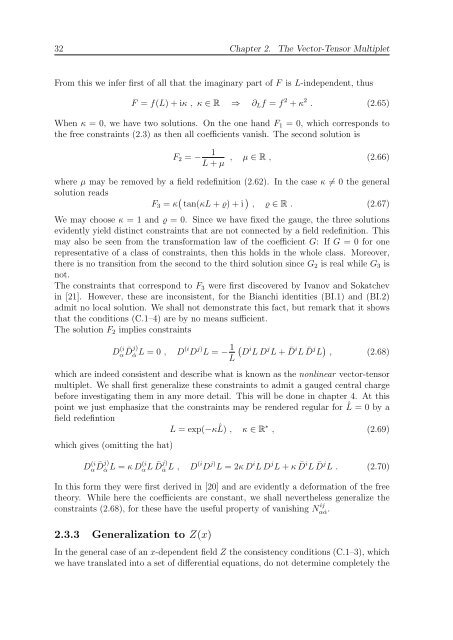N=2 Supersymmetric Gauge Theories with Nonpolynomial Interactions
N=2 Supersymmetric Gauge Theories with Nonpolynomial Interactions
N=2 Supersymmetric Gauge Theories with Nonpolynomial Interactions
You also want an ePaper? Increase the reach of your titles
YUMPU automatically turns print PDFs into web optimized ePapers that Google loves.
32 Chapter 2. The Vector-Tensor Multiplet<br />
From this we infer first of all that the imaginary part of F is L-independent, thus<br />
F = f(L) + iκ , κ ∈ R ⇒ ∂Lf = f 2 + κ 2 . (2.65)<br />
When κ = 0, we have two solutions. On the one hand F1 = 0, which corresponds to<br />
the free constraints (2.3) as then all coefficients vanish. The second solution is<br />
F2 = − 1<br />
L + µ<br />
, µ ∈ R , (2.66)<br />
where µ may be removed by a field redefinition (2.62). In the case κ = 0 the general<br />
solution reads<br />
F3 = κ tan(κL + ϱ) + i , ϱ ∈ R . (2.67)<br />
We may choose κ = 1 and ϱ = 0. Since we have fixed the gauge, the three solutions<br />
evidently yield distinct constraints that are not connected by a field redefinition. This<br />
may also be seen from the transformation law of the coefficient G: If G = 0 for one<br />
representative of a class of constraints, then this holds in the whole class. Moreover,<br />
there is no transition from the second to the third solution since G2 is real while G3 is<br />
not.<br />
The constraints that correspond to F3 were first discovered by Ivanov and Sokatchev<br />
in [21]. However, these are inconsistent, for the Bianchi identities (BI.1) and (BI.2)<br />
admit no local solution. We shall not demonstrate this fact, but remark that it shows<br />
that the conditions (C.1–4) are by no means sufficient.<br />
The solution F2 implies constraints<br />
D (i<br />
α ¯ D j)<br />
˙α L = 0 , D(iD j) L = − 1 i j<br />
D L D L + D¯ i<br />
L D¯ j<br />
L , (2.68)<br />
L<br />
which are indeed consistent and describe what is known as the nonlinear vector-tensor<br />
multiplet. We shall first generalize these constraints to admit a gauged central charge<br />
before investigating them in any more detail. This will be done in chapter 4. At this<br />
point we just emphasize that the constraints may be rendered regular for ˆ L = 0 by a<br />
field redefintion<br />
L = exp(−κ ˆ L) , κ ∈ R ∗ , (2.69)<br />
which gives (omitting the hat)<br />
D (i<br />
α ¯ D j)<br />
˙α<br />
L = κ D(i<br />
α L ¯ D j)<br />
˙α L , D(iD j) L = 2κ D i L D j L + κ ¯ D i L ¯ D j L . (2.70)<br />
In this form they were first derived in [20] and are evidently a deformation of the free<br />
theory. While here the coefficients are constant, we shall nevertheless generalize the<br />
constraints (2.68), for these have the useful property of vanishing N ij<br />
α ˙α .<br />
2.3.3 Generalization to Z(x)<br />
In the general case of an x-dependent field Z the consistency conditions (C.1–3), which<br />
we have translated into a set of differential equations, do not determine completely the

















